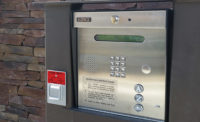If you have walked on almost any college or hospital campus, or visited a secondary school in the past several years, chances are you have seen a proliferation of both “blue light” emergency stations and entry control intercoms. Safety and security have always been a priority for these facilities, and these types of products are very popular options.
However, changes in technology in recent years have vastly altered the landscape on the sales and installation sides, as well as the functionality of the systems themselves. Much like video, which moved quickly from analog to IP, the entry control intercom and emergency station market also has been revolutionized by the advent of IP networks.
For one thing, the physical limitations that impacted how far wire could be pulled have completely gone away. Now the distance you can go with these types of products is virtually “limitless,” says Paul Hefty, technical sales and support engineer II, Aiphone Corp., Redmond, Wash. “IP has opened up possibilities. In the past you were limited to this or that distance. Now all bets are off. You can put things anywhere. In areas where you could maybe get power but not wire, anything is possible. If someone can imagine having a need for something somewhere, they can put it in.”
This means that these types of solutions now can be offered in places that were difficult before, he adds. “Because of distance limitations, perimeter gates either had to use a telephone-based system or it couldn’t be done. Now any of these are able to come back over the wireless network.”
Another benefit to IP-based systems is the ability to monitor what is going on, says Craig Szmania, regional business development head for 2N, an Axis Company, Chelmsford, Mass. The manufacturer of IP-based access control intercoms and audio products was acquired by Axis in 2016 and was fully integrated into the organization in 2018. “On emergency stations you can now do health monitoring. Is that device actually up and running? There have been stories where people needed help and went to the station and the button didn’t work. With an analog system you had no way of knowing that. But with a networked system you do. You can run diagnostics constantly,” Szmania describes.
Hefty adds this type of connectivity has other benefits, as well. “Having network-based equipment means everything can be programmed and you can do a lot more blending of stuff you never even thought was possible.”
He cites an example of customers who wanted to tie their intercom to the door to make a sound when it opened and closed. From a basic sound to complex instructions this is now much easier to do, he says. “We can make it say, ‘Please come in,’ ‘See the receptionist on the left,’ or ‘Welcome to X Corporation.’”
Integration is a hot topic around emergency communication solutions, says Michael Zuidema, marketing operations manager, Code Blue Corp., Holland, Mich. “Providing increased levels of flexibility and interoperability — without sacrificing reliability — can help boost safety and security.”
Bob Shanes, vice president of sales for Talkaphone, Niles, Ill., agrees. “Entry control now has HD-quality video capabilities paired with voice and integrated with video surveillance, access control and IP telephony systems. Emergency stations can also have the same features built in, in addition to mass notification.”
REVENUE OPPORTUNITIES
“As a general best practice, it is best to make considerations on how to leverage existing systems for a given end user in order to maximize the value-add and the return on investment,” Shanes says.
Some manufacturers are trying to make upgrades even easier. 2N, for example, has an electronics module that can upgrade the “guts” of existing analog emergency stations and put them on the network, Szmania explains. “Our units can be used stand alone, or they can be put in existing call boxes or stations.” This is beneficial for the end user because the station is usually more costly than the electronics inside it. “All the brains of our products are in the unit. You plug in a PoE cable and you are done,” he says.
Today about 70 percent of the intercom and emergency call station market is still analog, Szmania says, but he estimates that is changing quickly. “The same thing happened with cameras. ... We are doing a lot of these changeouts; our estimate is that within five years 70 percent of new installs will be IP and 30 percent will be analog because of the benefits of a networked product.”
He points to markets such as unmanned banking and new hospital applications as two examples of IP-based benefits. “The market is growing dramatically for using intercoms. It is growing both width-wise and depth-wise. Now you need communication systems that can reach someone three states over. There are banks that don’t have anyone sitting there. There are just kiosks that reach a remote person,” Szmania describes.
Aiphone also has a way to upgrade its older units. “We have a couple adapters,” Hefty says. “We have our old legacy speaker systems that are 30 to 40 years old and there are a ton of them out there.”
The company provides a network adapter box that allows an existing unit and infrastructure to be repurposed. “Typically we end up removing the older large system that takes up half the desk with 40 to 80 buttons for something modern and sleek.”
Hefty has started to see some security dealers and integrators take advantage of these. “They are realizing it is more cost-effective to put in these adapters than to re-pull wire.”
USEFUL ADVICE
Whether you plan to go back to existing customers to upsell them the new IP opportunity, or are working with a new customer, there are some things to be aware of when designing and installing IP-based entry control or emergency stations.
“Know your client’s environment,” advises Jim Hoffpauir, president, Zenitel USA, Kansas City, Mo. “Know the roadmap and the goals as well. If you install low-quality stations driven by a perception of low price at the beginning it may cost you over time as you deal with intelligibility, interoperability and scalability.”
Scalability is a theme that continues to come up. Particularly with analog-based systems, scalability was a very limiting factor, Hefty says. “It comes down to what is the biggest it can possibly grow to? How large is your system going to be? A lot of people focus on the specific needs for one area. In the past we have had customers call us six months later and want to expand, only to learn they bought a limited-capacity system.”
Luckily with IP systems this is not as much of an issue, but this means future-proofing needs to be top of mind.
“Focus on scalability,” Zuidema says. “End users can start small and grow their emergency communication system in the future as the needs and requirements of their locations change and technology evolves.
“Whether it is a new installation or an expansion of an existing project, it is important to accurately detail the function of each [station]. New products should seamlessly integrate with existing, while also identifying potential future work. Layering emergency communications devices with other security products, such as video cameras, access control or public address systems, will also require you to pay particular attention to integration,” Zuidema explains.
When talking about integration in particular it is very important to manage expectations, Shanes says. “It is best to gather feedback and input in the planning/design phase from parties such as security, facilities management and IT/networking/telecom.”
Hefty agrees. “Because it is networked-based equipment you need to talk to a network administrator.”
Szmania sums up all these ideas neatly. “From a designing and installing standpoint there are really three things to consider. They are basic, but people forget. First the designer has to have a clear understanding of the needs and goals of the end users…. Next is ensure you have all the different departments involved with the network…. And lastly, think long-term. Installing a network system is like a marriage. If you do it right you can have a customer for life as the system grows and expands.”
More Online
For more on entry control and emergency stations visit SDM’s website where you will find the following articles:
“It’s Time to Rethink INTERCOMS”
www.SDMmag.com/time-to-rethink-intercoms
“Entry Control’s Expanding Role in the Connected
Environment”
www.SDMmag.com/entry-controls-expanding-role
“IP and Cellular Technologies Have Revolutionized the Door Intercom or Telephone Entry System”
www.SDMmag.com/ip-cellular-tech
“Emergency Communications: Beyond the Blue Box”
www.SDMmag.com/beyond-the-blue-box





